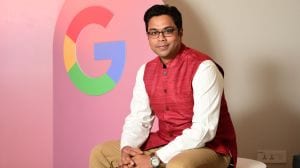Silver cloud, dark lining
...

It is a cardinal rule of Indian politics that old men do not retire, nor do they fade away. They live on and on to fight another day. So while youth, vim and vigour are the hallmark of politicians in other countries, age, experience, and decrepitude are the defining features of our leaders.
In the hardnosed, cut-throat world of corporate finance, managers at 45 make way for younger whiz kids, in banks, people over 50 are encouraged to opt for voluntary retirement. Tony Blair became a PM at 44 and sired his fourth child while in office. Bill Clinton was 47 when elected president and his boyish good looks turned on many women (apart from Monica Lewinsky). George W Bush, considered elderly by American standards, is still on the right side of 60. So is Russia’s Vladimir Putin, who has a black belt in judo. And in China, the Communist Party has decreed that party bosses over 70 will have to step down.
But in Indian politics, you usually start climbing up the ladder only when you reach the last lap of your life. Consider the following: Prime Minister Atal Behari Vajpayee is 76 and disinclined to step down to make way for a younger successor, L K Advani, 75, despite gentle hints from some quarters of the BJP and RSS. A section of his party believes that Vajpayee, in fact, is the ideal choice as President of India after K R Narayanan, 82, retires in March. Narayanan himself remains a strong contender for a second-term despite his indifferent health. He had trouble climbing the podium to deliver his address to the recent joint session of Parliament. He read his speech sitting down. Still, Narayanan’s brain remains razor sharp, which cannot be said of some of his predecessors in office.
Towards the end of his tenure as president, Shankar Dayal Sharma had a tendency to ramble in his speeches. Once, while addressing a Waqf board meeting, he delivered a discourse on Vedanta. At times, he became emotional and tears flowed freely. He waddled rather than walked and once toppled over his dhoti at a samadhi. His press officer spent the rest of the day trying to persuade newspaper editors not to carry the embarrassing shots in the next day’s newspapers. In India, Sharma’s idiosyncrasies were acceptable because of his high stature, but our diplomats abroad found it hard to explain his behaviour during his frequent trips away from home.
In the forthcoming presidential and vice presidential elections, the key contenders are: Vice-President Krishan Kant, 75; P C Alexander, 81; Karan Singh, 71; L M Singhvi, 70; and Najma Heptullah, 62. Though Heptullah appears to have all the right attributes in other respects, she will probably lose out because of her relative ‘‘youthfulness.’’ The thumb rule in selections for such posts is that youth must defer to age.
Here in India, talented aspiring young hopefuls grow old, bitter and jaded waiting endlessly for their turn to come. Take Chandra Shekhar for example: In 1977, the Young Turk who had rebelled against the Congress establishment and was jailed for 19 months during the emergency by Indira Gandhi, was under 50 and an emergency hero. As Jayaprakash Narayan’s favourite, he seemed the obvious choice to head the new government at the dawn of what promised to be a new era. But Morarji Desai, over 80 – along with two other wily old veterans Charan Singh and Jagjivan Ram — ensured that Shekhar was not in the reckoning in the leadership stakes. Cartoonist Abu Abraham summed up the general mood of frustration at the aged edging out youth with a cartoon depicting old men leaning on their walking sticks jostling for power with the caption ‘‘Bliss was it to be alive in that era, to be young was very heaven.’’
Shekhar learnt his lessons on the survival skills of the elderly well. He, in turn, refused to make way for younger rivals. As permanent president of the Janata Party, he ensured that no one — from an earnest Madhu Dandavate to a pugnacious Subramaniam Swamy — dared challenge him on his turf. The aging young Turk finally made it as PM for a brief six months only when he was 63. At 75 come April 17, he is still waiting for his second coming.
Sharad Pawar is another personable, youthful contender for the top slot who has aged and lost his dynamic image waiting endlessly to become Congress party chief. Pawar was under 40 when he became CM of Maharashtra for the first time and seemed to have plenty of time on his side for his ultimate ambition. Rajiv Gandhi may have been four years younger than Pawar, but he was the heir to the Gandhi dynasty, so his besting Pawar was inevitable. But what hurt was that Pawar was beaten in the leadership sweepstake by two aged backroom players, Narasimha Rao and Sitaram Kesri, who were devoid of either looks or charisma and were a dead loss in any election campaign. Their advantage — as is the case with all elderly contenders for power — is that other hopefuls viewed them as less of a threat since they would not be around indefinitely.
Sonia Gandhi, 55, on taking over as party president decided to get rid of some of the party deadwood. After Rajiv’s death, the CWC had become something of an old folks’ home. Apart from Rao and Kesri, there was Arjun Singh, now 71, leaning heavily on his walking stick and K Karunakaran, now 83, disjointed and doddering. But despite his age and faltering health, Karunakaran fought tooth and nail to avoid being sidelined. Visitors to the old veteran find him still sulking and hoping for a return to the centrestage.
Presidents of all political parties tend to stick on to their posts indefinitely. The DMK’s M Karunanidhi continues as party president at 78. In fact, Vaiko left the DMK and formed his own MDMK after he realised that there was no prospect for growth under a banyan tree. In the CPI(M), Jyoti Basu talked occasionally of retirement but did not step down as CM of West Bengal till past 80. At the recent CPI(M) congress in Hyderabad, Harkishen Singh Surjeet, 86, though hard of hearing, a bit unfocussed and slightly disheveled, refused to relinquish his post for a younger man like Prakash Karat.
The elderly BJP brains trust, most of whom are bachelors, is further proof of the fact that there is no such word as ‘retirement’ in the Indian politician’s lexicon. Present party president Jana Krishnamurthy is a frail 73, former BJP president Kushabhau Thakre is 79 and his faltering voice and doddering looks ensure that his TV appearances are public relations disasters for the BJP. Vajpayee’s knee problems and forgetfulness of names — in his recent speech he referred to Clinton as Lincoln — and long pauses, compare unfavourably at summits with President Musharraf, a trim and glib 59-year-old.
Generally, other countries have heads of government who are far more telegenic and media savvy than our recent string of elderly PMs, Narasimha Rao, Deve Gowda, I K Gujral and Vajpayee, with their ill health, limp handshakes and tendency to stealing catnaps even when the camera is focussed on them.
Our last youthful PM, Rajiv Gandhi, was just 50 when elected. The sweeping majority he received in the general election of 1985, bettering the best electoral showings of both his mother and his grandfather, was in all probability the electorate’s desire for a young fresh face and a break from the tired old men of the past.
But look at it from the politician’s point of view. Staying on in office is the best way to ensure that age doesn’t catch up with them and their families are well looked after. It is noticeable that politicians, while they frame rules for others about retirement age and limited tenures for posts, ensure that no such restriction applies to them. The Indian Constitution does not fix a limit on the number of terms in office for posts like PM, CM and president.
I once asked Sikander Bakht, 83, would-be governor of Kerala, why there was no retirement policy for politicians. My query was in the context of the performance of then UP chief minister Ram Prakash Gupta, 78, whose forgetfulness had made him the butt of many jokes. Bakht felt that if a politician’s age started to tell then he should step down gracefully, ‘‘Where have they produced this namoona (specimen) from?’’ he queried of Gupta. But he insisted that one couldn’t generalise about aging politicians. As a former hockey player, he himself had remained fit and active.
Bakht is surely better preserved than some of his fellow governors such as Sundar Singh Bhandari, 80, P C Alexander, 81 and Vishnu Kant Shastri, 72. And certainly he is more agile than a former Orissa governor who some years back was brought in on a stretcher to preside over a function.
|
and Elsewhere…
|
||||
|
Clockwise from top left: British Prime Minister Tony Blair, US President George W Bush, Japanese Prime Minister Junichiro Koizumi, German Chancellor Gerhard Schroeder, Pakistani President Pervez Musharraf, Indonesian President Megawati Sukarnoputri.
|
||||
Photos


- 01
- 02
- 03
- 04
- 05





























